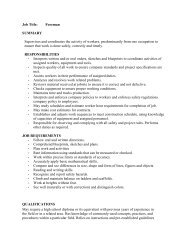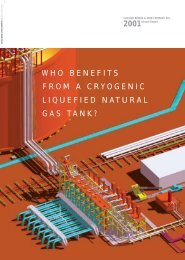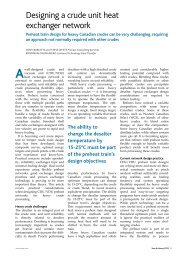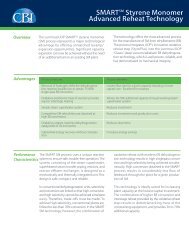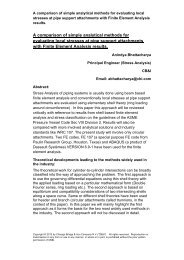News Welcome to CB&I World Technology & Innovations Special ...
News Welcome to CB&I World Technology & Innovations Special ...
News Welcome to CB&I World Technology & Innovations Special ...
- No tags were found...
Create successful ePaper yourself
Turn your PDF publications into a flip-book with our unique Google optimized e-Paper software.
<strong>News</strong>New Contracts & Safety<strong>Welcome</strong> <strong>to</strong> CB&I <strong>World</strong>Message from Philip Asherman<strong>Technology</strong> & <strong>Innovations</strong>Global Engineering Services Center<strong>Special</strong> FeaturesInterview with <strong>World</strong> Energy<strong>World</strong> FocusCurrent Projects
In this Issue<strong>Welcome</strong>3 WELCOME TO CB&I WORLDMessage from Philip Asherman14 AUSTRALIAWoodside Phase V LNG Expansion ProjectProduced byCB&IEdi<strong>to</strong>rKaterina McGregorCB&I40 Eastbourne TerraceLondon W2 6LG, UKTel: 44 (0) 207 053 3532Fax: 44 (0) 207 053 3895e-mail kmcgregor@CBI.comEdi<strong>to</strong>rial Advisory PanelChip Ray, Bruce Steimle,Suzanne GatesDesignMark WestMITIE Document SolutionsTel: 44 (0) 207 015 9417<strong>News</strong>4 NEWS & CONTRACTS5 SAFETY NEWS<strong>World</strong> Focus:Current Projects7 EUROPEBuilding the Isle of Grain LNGImport Terminal8 MIDDLE EASTPearl GTL Project in Qatar9 AFRICAGas Processing Plant Under Way in Angola10 NORTH AMERICAGolden Pass LNG Facility in Texas<strong>Special</strong> Features16 CB&I DIFFERENCE:Providing Innovative Results <strong>to</strong> the<strong>World</strong>wide LNG Industry<strong>Technology</strong> & <strong>Innovations</strong>18 Global Engineering Services CenterMarketing <strong>News</strong>19 TradeshowsNew CB&I VideosHot Off the Press11 CENTRAL & SOUTH AMERICALNG Liquefaction Project in Peru12 ASIAChina’s First Fully Owned LNG ImportTerminalwww.CBI.comproductionprocessings<strong>to</strong>ragedistribution2This document is intended for general information purposes only and does not in any way constitute offer <strong>to</strong> provide specific services. Some services may not be available incertain countries or political subdivisions thereof. All the quotations in this document have been reproduced with the kind permission of our cus<strong>to</strong>mers.Any enquiries about content from this publication should be directed <strong>to</strong> the Edi<strong>to</strong>r (email: kmcgregor@CBI.com)©Copyright 2007 by Chicago Bridge & Iron Company. All rights reserved. Printed in UK. CW07-06
<strong>News</strong> & ContractsCB&I Expands Engineering Capacity with New Middle EastCenterFeb. 15, 2007 - CB&I announced that it has opened a new globalengineering center in the Middle East <strong>to</strong> address the increaseddemand for engineering work resulting from the Company’s stronggrowth in new project awards.Located in Ajman, northeast of Dubai in the United Arab Emirates, thecenter will expand CB&I’s current worldwide engineering resources. Ithas space <strong>to</strong> house more than 200 engineers and support staff, andwill utilize a wide range of engineering software platforms, facilitatingwork sharing between offices and flexibility in responding <strong>to</strong> cus<strong>to</strong>merrequirements. Drawing from a pool of talented, <strong>to</strong>p quality engineersbased in the UAE, the Ajman facility will help CB&I continue <strong>to</strong> deliverquality engineering support <strong>to</strong> projects across all of its global markets.The center is expected <strong>to</strong> be working at full strength by the fourthquarter of 2007.“Maintaining and enhancing our engineering resources is critical<strong>to</strong> the continued success of CB&I’s business model as a complete,sole-source EPC provider,” noted John Redmon, CB&I’s ExecutiveVice President – Operations. “With an initial focus on the detailedengineering of process facilities, our new center in the UAE willaugment our capability <strong>to</strong> provide high-value design solutions <strong>to</strong> oiland gas cus<strong>to</strong>mers worldwide.” (See page 18 for more information).CB&I Awarded LNG Liquefaction Project in PeruWill Provide EPFC for South America’s First Baseload LNG ExportFacility. Jan. 23, 2007 - CB&I has been awarded a contract by Peru LNGS.R.L. for the engineering, procurement, fabrication, construction, andcommissioning of a liquefied natural gas (LNG) liquefaction plant inPampa Melchorita, Peru, located about 170 kilometers south of Lima.CB&I’s commercial scope of work is valued in excess of US$1.5 billion.Peru LNG S.R.L. is a consortium comprised of Hunt Oil Company of theUnited States, SK Corporation of Korea and Repsol YPF S.A. of Spain.CB&I’s work includes the entire liquefaction plant, with a designedproduction capacity of 4.45 million <strong>to</strong>ns per year of LNG. The projectencompasses treatment of the inlet gas, liquefaction, two LNG tanks,ship loading facilities, power generation, plant utilities, and relatedancillary buildings and systems.CB&I’s experience in the LNG industry includes the design/buildresponsibility for dozens of regasification terminals worldwide,as well as the mechanical erection of LNG liquefaction plants inMalaysia, Nigeria and Australia. Overall, CB&I has built more than 40LNG terminals and peak shaving facilities on a turnkey EPC basis. “Weappreciate the confidence shown by Peru LNG in selecting CB&I for thissignificant project,” said Philip K. Asherman, CB&I’s President and CEO.“This award builds on our decades of proven worldwide experiencein the LNG industry and capitalizes on CB&I’s extensive his<strong>to</strong>ry in Peruand throughout Latin America.” CB&I has worked in Peru for more than40 years, and plans <strong>to</strong> draw upon the excellent Peruvian labor force forthe execution of this project. Among its experience in the country,CB&I has been involved in the Camisea natural gas project since itsinception, providing cryogenic gas processing facilities and s<strong>to</strong>ragefor gas liquids. The Peru LNG project provides organic growth for CB&Iin this market and capitalizes on the company’s comprehensive gasprocessing capabilities.CB&I’s scope consists of EPCM and fabrication services associatedwith the revamp and expansion of the refinery’s fluid catalyticcracking unit (FCCU), along with a 11,500 barrel per day grassrootsliquefied petroleum gas (LPG) Merox unit. The upgrade is part of therefinery’s gasoline optimization program. Mechanical completion isscheduled for 23 months from time of award. The project work forceis expected <strong>to</strong> peak at more than 1,000 workers. Merox is a licensedextraction process developed by UOP LLC <strong>to</strong> reduce the mercaptansulfur content from LPG, naphtha and gasoline streams. CB&I has analliance with UOP <strong>to</strong> provide engineering, procurement, fabricationand site construction services for Merox unit installations throughoutthe Americas.Qatar Shell GTL Limited Awards EPC Project <strong>to</strong> CB&INov. 16, 2006 - CB&I has been awarded an engineering, procurementand construction (EPC) contract by Qatar Shell GTL Limited for thePearl Gas <strong>to</strong> Liquids (GTL) project in Ras Laffan, Qatar. The Pearl GTLProject is a joint development by Royal Dutch Shell plc and QatarPetroleum.CB&I’s work scope for the project consists of the engineering,procurement, fabrication and construction of two s<strong>to</strong>rage facilitieswith a combined s<strong>to</strong>rage capacity of 900,000 cubic meters; 120kilometers (approximately 75 miles) of piping systems; and allassociated mechanical, civil, building, electrical and instrumentationworks for the project. The onsite work force is expected <strong>to</strong> peak at1,000 employees.“We are pleased <strong>to</strong> build upon our long association with Shell andQatar Petroleum for this significant project,” said Philip K. Asherman,CB&I’s President and CEO. “CB&I has been working in Qatar for morethan 35 years, and we have recently completed a number of projectsin Ras Laffan Industrial City. We are confident that our presence andexperience in the region will enable us <strong>to</strong> rapidly mobilize for thisproject and meet our and Qatar Shell’s expectations for safety, qualityand schedule performance.” The Pearl GTL project comprises thedevelopment of upstream gas production facilities and an onshoreGTL plant that will produce 140,000 barrels per day of GTL productsand approximately 120,000 barrels per day of condensate, liquefiedpetroleum gas and ethane. When completed, it will be the world’slargest integrated GTL complex.Official Opening of CB&I House in LondonOn 25th Oc<strong>to</strong>ber 2006, CB&I held the official opening of CB&I House- the new London office located at 40 Eastbourne Terrace - CB&I’sregional headquarters for Europe, Africa and the Middle East (EAME).CB&I’s guest of honor - The Rt Hon Malcolm Wicks, MP, UK Ministerfor Energy performed the official dedication and ribbon cuttingceremony <strong>to</strong> commemorate this significant event.4CB&I Awarded Refinery Expansion Project in CaribbeanJan. 10, 2007 - CB&I has been awarded a contract for a refinery upgradeproject at a Caribbean oil refinery. The award, which was booked inthe fourth quarter of 2006, is valued in excess of US$75 million.Picture: UK Minister of State for Energy, Rt. Hon Malcolm Wicks (center) performingthe CB&I House opening ceremony
Safety <strong>News</strong>At CB&I, protecting the environment and the health of our employees, cus<strong>to</strong>mers, subcontrac<strong>to</strong>rs and the public in the areaswhere we work and live is a key component of our culture.Every employee across the organization is responsible for using safe work practices in their job every day, and it is theircommitment <strong>to</strong> do so that has helped us achieve a record of exemplary safety performance year after year. As a company, westrive <strong>to</strong> do the right things for the right reasons, embracing all HSE regulations and educating our employees through extensiveand ongoing training programs. We developed our goal of zero incidents because anything short of that is unacceptable, andwe are all accountable for achieving that goal-every day on every job.Rhudy Honored by National Safety CouncilThe US National Safety Council (NSC) recently announced itsDistinguished Service <strong>to</strong> Safety Award (DSSA) recipients for 2006.The DSSA is the highest honor bes<strong>to</strong>wed on an individual safetyprofessional by the NSC in recognition of outstanding service <strong>to</strong> thefield of safety. The eight recipients, including CB&I’s Jim Rhudy, wereinducted during the November 2006 opening session of the NationalSafety Council’s 94th Annual Congress. Rhudy, Vice President Health,Safety and Environment, has been active in the NSC since 1974.For more that 35 years Rhudy has been involved in CB&I’s Health,Safety and Environmental (HSE) program, serving in various positionsincluding Manufacturing and Construction Manager of Safety,Corporate Regula<strong>to</strong>ry Coordina<strong>to</strong>r and Corporate Direc<strong>to</strong>r of HSE. In2002 he was promoted <strong>to</strong> his current position, assuming responsibilityfor policies, procedures and standards for the HSE compliance of thecorporation.Safety Merit Award in USCBI Services recently received a Certificate of Merit Award from theNational Maintenance Agreements Policy Committee (NMAPC). CBIServices was recognized for performing 196,592 work-hours withzero recordable injuries during the construction of the 45 MMSCFDHydrogen Plant for ConocoPhillips in Wood River, Illinois. Thisprestigious award, which acknowledges world class safety and healthperformance, was presented by the NMAPC Executive ManagementCommittee at the annual awards ceremony held in Washing<strong>to</strong>n, D.C.,USA.Celebrating in ColombiaA CB&I crew was honored by our cus<strong>to</strong>mer, Propilco, for completing100 days without an accident. Propilico awarded the crew with acertificate commending each crew member for their part in achievingthis early target goal in the project. The project consists of the erectionof a splitter column and five high pressure spheres in Cartagena,Colombia, and is scheduled <strong>to</strong> complete at the end of May 2007.CB&I Superintendent Receives National Grid Safety AwardSteve Rathjen, Senior Superintendent on the Isle of Grain LNG projectin the UK, has received National Grid plc’s Chairman’s Award for SHE(Safety, Health and Environmental) Achievement from Sir John Parker,Chairman of National Grid, CB&I’s cus<strong>to</strong>mer and owner of the LNGimport terminal.In his letter <strong>to</strong> Rathjen, Sir John Parker notes: “… the Board placesgreat emphasis on the progress we have made in our safety, healthand environmental performance and so being recognized by acolleague at National Grid as making an outstanding contribution <strong>to</strong>our business is a clear endorsement of your efforts.”Rathjen was nominated for the award last year, shortly after the Isleof Grain project achieved 1 million work-hours without a recordableinjury in September 2006. He has been with CB&I for about eightyears, and has worked previously on projects in Nigeria and Australia.Tyler Safety Personnel HonoredThe East Texas Chapter of the American Society of Safety Engineers, attheir monthly meeting in December 2006, presented Service AwardCertificates <strong>to</strong> their members who had been in ASSE for 10, 20 and 30years. A number of CB&I’s HSE Managers received the 10 year servicecertificates.CB&I Recognized by Cus<strong>to</strong>mers for Safety AchievementsIn August 2006 the CB&I crew on the Habshan Project in the MiddleEast received a safety recognition plaque from Bechtel for contributing<strong>to</strong> the five million hours worked without a lost time accident on theOGD Project.In September 2006 the Sakhalin Island LNG project team wascommended by our cus<strong>to</strong>mer in Russia as it reached 5,000,000 hoursworked with zero lost time accidents.James R. RhudyOutstanding Safety Achievements in the Middle EastIn December 2006 a safety dinner was held for CB&I WarehouseManager Joseph George and Warehouse Superintendent Rick Puhland their crew for achieving 1.5 million work-hours without a losttime accident. They accumulated these work-hours over a period ofnine years which makes it an extraordinary achievement.5
EUROPEBuilding the Isle of Grain LNG Import TerminalCB&I is currently participating in one of the major LNG projects in Europe – National Grid’s Grain LNG terminal expansion.The UK is turning <strong>to</strong> imported LNG <strong>to</strong> make up for a drop in gas production from its mature North Sea fields. The expansionwill increase capacity at the facility which provides a significant new source of natural gas for the UK’s National TransmissionSystem.6Grain LNG SummaryThe Isle of Grain, set between the estuaries of the RiversThames and Medway, has long been a center of industrialactivity providing energy resources <strong>to</strong> London and the SouthEast of England. The area has a long tradition of industrialland use and lies just across the water from Canvey Islandwhere the UK´s first LNG imports were landed back in the1960s.At the turn of the millennium, with gas demand in theUK rising and domestic production in decline, it becameapparent that a significant proportion of the country’s gaswould have <strong>to</strong> be imported <strong>to</strong> help fill the supply gap.Against this background National Grid Grain LNG Limited, awholly owned subsidiary of National Grid, <strong>to</strong>ok the decision <strong>to</strong>convert an existing LNG s<strong>to</strong>rage site in<strong>to</strong> an LNG importationand regasification terminal at the Isle of Grain <strong>to</strong> support thegrowing demand.The site at Grain is ideally suited since National Grid alreadyowned the existing peak shaving plant and a significant areaof land. In addition, it has natural deep-water access as theRiver Medway and the sea approach is deep enough for thelargest LNG ships, carrying up <strong>to</strong> 205,000 cubic meters of LNG,<strong>to</strong> berth. The site also has an existing connection <strong>to</strong> the highpressure National Transmission System (NTS).
The first phase of the project, completed in mid 2005, sawthe conversion of the existing facility <strong>to</strong> an LNG importterminal with an initial capacity of 3.3 million <strong>to</strong>nnes of LNGper year, approximately 4% of the UK’s gas demand. The Isleof Grain terminal thus became the first of the country’s newLNG importation facilities.CB&I is currently participating in work <strong>to</strong> expand the terminalcapacity, which will enable LNG throughput at the site <strong>to</strong> beincreased by 6.5 million <strong>to</strong>nnes per annum, making a <strong>to</strong>talcapacity of up <strong>to</strong> 9.8 million <strong>to</strong>nnes per annum, approximately12% of current UK gas demand.CB&I RoleIn March 2005 CB&I was awarded the lump-sum turnkeycontract with a value estimated between US$470 - $500million for the expansion of the terminal.CB&I has complete engineering, procurement andconstruction (EPC) responsibility including an increase in theregasification and sendout capacity <strong>to</strong> 1 billion cubic feetper day, increased boil-off gas handling capacity, three fullcontainment 190,000 cubic meter LNG s<strong>to</strong>rage tanks, a newcontrol facility, and associated systems.Project ProgressFollowing award the CB&I team mobilized first in the CB&ILondon Padding<strong>to</strong>n office with supporting teams in bothPlainfield and Dubai.There are currently 750 people working on the project withprogress on schedule at approximately 60%. In December2006 the project celebrated the air raise of the roof on the thirdtank.As work on site progresses apace, safety is the No. 1 priority.One example of this commitment is that more than 2,500people have now undergone site safety inductions. This levelof effort resulted in over 1 million work-hours being achievedwith no lost time injuries.The onsite team decided <strong>to</strong> celebrate this achievement bymaking a contribution from National Grid and CB&I <strong>to</strong> twolocal charities.Mike J Whitney7
Pearl GTL Project in QatarMIDDLE EASTIn GTL (Gas <strong>to</strong> Liquids) natural gas is chemically convertedin<strong>to</strong> clean fuels and other valuable products. GTL iscomplementary <strong>to</strong> LNG and pipelines and helps countries<strong>to</strong> diversify their energy supplies. Moreover, gas-basedproducts are inherently cleaner than oil products.The Pearl Gas <strong>to</strong> Liquids (GTL) project includes thedevelopment of offshore natural gas resources in Qatar’sNorth Field. The Pearl GTL project comprises the developmen<strong>to</strong>f upstream gas production facilities as well as an onshoreGTL plant that will produce 140,000 barrels per day (bpd)of GTL products as well as approximately 120,000 bpd ofassociated condensate and liquefied petroleum gas. Theproject will be developed in two phases with the first phaseoperational around the end of the decade. The second phasewill be completed around one year later. The project includesthe development of a block within Qatar’s vast North Fieldgas reserves, which will produce 1.6 billion cubic feet per dayof natural gas.This world-scale project allows the State of Qatar <strong>to</strong> build anew industry, which will provide an alternative way <strong>to</strong> utilizeQatar’s enormous gas resources in an economically robustand environmentally constructive way and helps realizeQatar’s ambition <strong>to</strong> become the “GTL capital of the world”.In November 2006 CB&I was awarded an engineering,procurement and construction (EPC) contract by Qatar ShellGTL Limited for the Pearl Gas <strong>to</strong> Liquids (GTL) project in RasLaffan, Qatar. The Pearl GTL Project is a joint development byRoyal Dutch Shell plc and Qatar Petroleum.CB&I’s work scope for the project consists of the engineering,procurement, fabrication and construction of two s<strong>to</strong>ragefacilities with a combined s<strong>to</strong>rage capacity of 900,000 cubicmeters; 120 kilometers (approximately 75 miles) of pipingsystems; and all associated mechanical, civil, building, electricaland instrumentation works for the project.The onsite work force is expected <strong>to</strong> peak at 1,000 employees.“We are pleased <strong>to</strong> build upon our long association withShell and Qatar Petroleum for this significant project,” saidPhilip K. Asherman, CB&I’s President and CEO. “CB&I has beenworking in Qatar for more than 35 years, and we have recentlycompleted a number of projects in Ras Laffan Industrial City.We are confident that our presence and experience in theregion will enable us <strong>to</strong> rapidly mobilize for this project andmeet our and Qatar Shell’s expectations for safety, quality andschedule performance.”Following the award the CB&I team mobilized in the CB&IDubai office with supporting teams in London. The projectteam is growing and currently numbers more than 65 people.Working in close cooperation with our cus<strong>to</strong>mer, the CB&Iproject team looks forward <strong>to</strong> the safe and on-time executionof this world-scale project.Cal D Lipscomb8
NORTH AMERICAGolden Pass LNG Facility in TexasCB&I is currently participating in one of the major energyprojects in North America, building a grass roots LiquefiedNatural Gas (LNG) receiving terminal located near SabinePass, Texas. This new terminal will help meet the growingdemand for natural gas in the United States and <strong>to</strong> providea safe, reliable, long-term, competitive source of energy.The LNG terminal will be located approximately 10 milessouth of Port Arthur and two miles northwest of Sabine Pass,Texas. The Port Arthur area is an excellent location for anLNG receiving terminal because of its deep water navigationwaterways and easy access <strong>to</strong> the Gulf Coast. The region alsohas an existing pipeline infrastructure with access <strong>to</strong> SouthEast Texas and other U.S. markets.In July 2006 CB&I was awarded the contract by GoldenPass LNG Terminal LLC for the engineering, procurement,fabrication and construction of a liquefied natural gas (LNG)import terminal located near Sabine Pass, Texas. The awardis valued in excess of US$1 billion. CB&I has complete EPCresponsibility for the terminal, which will have an importcapacity <strong>to</strong> process 15.6 million <strong>to</strong>ns per year (MTA) of LNG,which is equivalent <strong>to</strong> approximately 2 billion cubic feet perday of natural gas. The project includes two ship unloadingberths; five full-containment LNG s<strong>to</strong>rage tanks, each with acapacity of 155,000 cubic meters; a regasification and sendoutsystem; and related ancillary buildings and systems.Initial engineering, procurement and site preparation activitiesare under way. Terminal start-up is planned for 2009. “We arepleased <strong>to</strong> have been chosen for this landmark project,” saidPhilip K. Asherman, CB&I’s President and CEO. “The Golden Passaward builds on our decades of proven worldwide experiencein the LNG industry. And it also marks an important miles<strong>to</strong>nein our longstanding relationships with Qatar Petroleum, ExxonMobil Corporation, and ConocoPhillips Company, as we work<strong>to</strong>gether <strong>to</strong> safely construct the Golden Pass LNG terminal <strong>to</strong>help meet the growing US energy demand.”Following the award, the CB&I team mobilized in the CB&IPlainfield office, located west of Chicago, Illinois. The projectteam is growing rapidly and currently more than 400 peopleare working on the project. Major commitments for equipment,materials, and major subcontracts have already been made. Thetemporary site facilities have been put in place and installationof the more than 1,200 piles for the first two tanks has beenachieved on schedule. CB&I plans <strong>to</strong> draw upon the excellentlocal labor force for the execution of this project and at itspeak, the project is expected <strong>to</strong> create over 1,000 constructionjobs in Southeast Texas.The CB&I project team has developed aclose working relationship with the client project team - bothlocated in the CB&I’s Plainfield office for the engineering andinitial procurement phase of the project.Steve Crain10
SOUTH AMERICALNG Liquefaction Project in PeruCB&I is currently participating in one of the most importantLNG projects in South America. The project includes theconstruction and operation of a world class LNG liquefactionfacility and marine export terminal on the west coast of Peruat Pampa Melchorita. The owners of the facility, Peru LNGS.R.L. is a consortium comprised of Hunt Oil Company ofthe United States, SK Corporation of Korea and Repsol YPFS.A. of Spain. The Peru LNG Export Project is a key strategicelement in Peru’s overall energy plan <strong>to</strong> exploit its extensivereserves in the Camisea gas fields by exporting them <strong>to</strong> othercountries. The project will monetize Peruvian natural gasresources in excess of local demand, providing the countrywith a sustainable export commodity. The Peru LNG ExportProject will position Peru <strong>to</strong> play a leading role in the expor<strong>to</strong>f liquefied natural gas from South America and will allowPeru <strong>to</strong> compete internationally with LNG exporters aroundthe world <strong>to</strong> meet the increasing demand for natural gas onthe North American continent. Once LNG production begins,anticipated in 2010, approximately $800 million from LNGexports will be added <strong>to</strong> the Peruvian economy, contributing<strong>to</strong> country’s energy independence and economic growth.CB&I has been involved in the Camisea natural gas projectsince its inception, providing cryogenic gas processingfacilities and s<strong>to</strong>rage for gas liquids. The Peru LNG ExportProject provides organic growth for CB&I in this market andcapitalizes on the company’s comprehensive gas processingcapabilities.In January 2007 CB&I was awarded the contract by PeruLNG S.R.L. for the engineering, procurement, fabrication,construction, and commissioning of the liquefied natural gas(LNG) liquefaction plant at Pampa Melchorita, Peru, locatedabout 170 kilometers south of Lima. CB&I’s commercialscope of work is valued in excess of US$1.5 billion. CB&I’swork includes the entire liquefaction plant, with a designedproduction capacity of 4.45 million <strong>to</strong>ns per year of LNG. Theproject encompasses treatment of the inlet gas, liquefaction,two LNG tanks, ship loading facilities, power generation, plantutilities, and related ancillary buildings and systems.Following the award the CB&I team mobilized in the CB&ILondon Padding<strong>to</strong>n office with supporting teams in Plainfield,Lima and The Woodlands. The project team is growing rapidlyand currently more than 250 CB&I people are working on theproject. Major commitments for materials, support servicesand civil construction have already been made.CB&I will draw upon its more than 40 years of experience inPeru and will utilize the industrious Peruvian labor force forthe execution of this project. The Peru LNG and CB&I projectteams, both located in the Padding<strong>to</strong>n engineering office forthe engineering and procurement phase of the project, havedeveloped a close working relationship.Peter Rano11
ASIAChina’s First Fully Owned LNG Import TerminalChina’s demand for liquefied natural gas is growing and LNGis beginning <strong>to</strong> play an important role in China’s continuingand rapid economic growth. As well as diversifying thecountry’s energy supply, it is leading <strong>to</strong> growth of the naturalgas pipeline network <strong>to</strong> meet industrial, commercial anddomestic needs. Today China is in the process of constructingand assessing the viability of a number of LNG importterminals along its entire coastline.According <strong>to</strong> recent economic predictions, LNG couldeventually account for up <strong>to</strong> 40% of all domestic naturalgas needs by 2020. China’s LNG imports could amount <strong>to</strong> 15million mt (20.7 billion cu m) by the end of this decade withfive LNG terminals projected <strong>to</strong> be in operation.The Fujian Terminal and Trunkline project represents China’sfirst fully-owned LNG import terminal. Fujian LNG (FJLNG) isa joint venture between the lead, China National Offshore OilCompany (CNOOC), and the Fujian Provincial Governmentrepresented by the Fujian Investment and DevelopmentCorporation ( FIDC).the LNG regasification terminal has Phase I capacity of 2.6million <strong>to</strong>nnes of LNG per year with Phase II expansion undermarket evaluation. The natural gas from the terminal will beprovided <strong>to</strong> gas-fired power plants that will be built during theproject’s first phase and <strong>to</strong> household users in five cities in theprovince via a 300 km trunkline.CB&I’s work scope for this project includes the turnkeyengineering, procurement, construction and commissioningof the terminal s<strong>to</strong>rage and system works, which encompassescivil, mechanical, piping, structural, buildings, and electricaland instrumentation work, and includes the marine loadingarms and regasification system. The terminal is scheduled forcommercial operation in early 2008.Following the awards, the CB&I team mobilized <strong>to</strong> theengineering offices for tank s<strong>to</strong>rage in Plainfield, Illinois, USAand for systems work in London. They were joined by teamsfrom FJLNG and our consortium partner and China DesignInstitute, Chengda <strong>to</strong> work on design and procurement of longlead materials and equipment.At this time, the tank design and detail engineering andprocurement are complete. The basic design and procuremen<strong>to</strong>f major equipment for the terminal is also complete. The teamshave shifted from London <strong>to</strong> Chengda engineering officesin Chengdu for detail engineering and local procurement.Resources for this work have been fully deployed.CB&I achieved 2.5 million work-hours without a lost timeaccident in September 2006 and the team is determined <strong>to</strong>continue this excellent safety performance. The introductionand enforcement of many new international standards andprocesses have contributed <strong>to</strong> the achievement. As workcontinues at high elevations and with the introduction of anew workforce for the terminal, the goal is <strong>to</strong> improve uponthe high standards implemented thus far in the project <strong>to</strong>maintain the current safety record.Douglas Willard12In April 2005, FJLNG awarded CB&I the lump-sum turnkeycontract for the two long-lead 160,000m 3 full containment LNGs<strong>to</strong>rage tanks for a contract value of $100 million. In December2005 FJLNG followed up this contract by awarding CB&I a lumpsumturnkey contract valued at approximately US$140 millionfor the design and construction of the terminal system works.Located in the city of Xiuyu, Fujian Province, in southeast China,Doug Willard, CB&I Project Direc<strong>to</strong>r for the Fujian LNG TerminalProject was presented with the “Excellent Project Manager” Awardby Fujian LNG Terminal and Trunk Line Project Owners during theannual award ceremony at Putian, Fujian Province, China. CB&I’sHSE group was also recognized with the “Best Safety Performance”award.
AUSTRALIAWoodside Phase V LNG Expansion Project in AustraliaCB&I is back on the Burrup Peninsula in Western Australia,building the process units for the Woodside -operated NorthWest Shelf Venture’s LNG Phase V Expansion Project. Aftersuccessfully completing Train IV in 2004, CB&I was selectedas the mechanical contrac<strong>to</strong>r <strong>to</strong> build the new 4.4 million<strong>to</strong>nnes per year LNG Train V as well as the acid gas removalunit, fractionation unit and other process additions <strong>to</strong> theproduction facility.In September 2006 CB&I was awarded the mechanical erectioncontract on the $2.4 billion Phase V Project by Woodside EnergyLtd., opera<strong>to</strong>r of the North West Shelf Venture onshore gasplant near Karratha, Western Australia. The Phase V expansionwill increase the plant’s capacity <strong>to</strong> 16.3 million <strong>to</strong>nnes peryear, making it one of the single largest LNG complexes in theAsia-Pacific region.CB&I’s work scope for the project includes the installationand hook-up of process modules in the LNG train and othermajor units, as well as the stick built structural, mechanicaland piping for Phase V. The scope includes pre-commissioningand commissioning assistance for the project. The Companymobilized on site in September 2006 after an offsite planningphase and expects <strong>to</strong> complete its portion of the project inthe first quarter of 2008. The excellent safety performanceachieved on the Train IV project is being continued on Train VLNG expansion project with 330,000 work-hours completed in2006 without a lost time incident.The LNG Phase V Expansion project is a world-first for modularconstruction. Never before has an LNG train been built viamodular construction. There are a <strong>to</strong>tal of 74 modules witha combined weight of 17,500 metric <strong>to</strong>ns. Of all the Phase Vmodules, none is bigger than 14101, the main liquefaction PAUwhich weighs approximately 1920 metric <strong>to</strong>ns and is 35 metersin height. 14101 is due at site in April 2007. The pho<strong>to</strong>graphshows the 14202 and 14203 rack modules arriving at theWoodside Rock Jetty at Dampier.2006 was an exceptional year for the project with thecompletion of site preparation and primary civil work includingmajor underground cabling, while the modules were beingassembled in Batam, Indonesia. The mechanical constructionwork began in Oc<strong>to</strong>ber 2006 with stick build steel erection andalignment of the first three modules by CB&I.2007 will present many challenges <strong>to</strong> maintain the currentconstruction schedule and <strong>to</strong> begin pipe testing and precommissioningactivities in the second half of the year. We willpeak at about 850 field crew in July through September withthe majority of our workforce on a regular R&R cycle requiringapproximately 7500 round trip airfares between Karratha andPerth in 2007.CB&I is working closely with Foster Wheeler Worley Parsons,the managing engineering contrac<strong>to</strong>r for the project, and alsowith Woodside on systems completion, pre-commissioningand commissioning activities <strong>to</strong> have a clean safe startup ofthe LNG train and other process units.Bob Brown14
GAL.WOODII.DOC2/13/2009 11:43 AM2009] ADVANCING THE SOVEREIGN TRUST (PART II) 105convey broader protection for public assets are likely <strong>to</strong> be upheld by courts. 78Second, where the agency has choices in formulating or operating projects such asdams, roads, and facilities, the trust duty requires selecting the alternative thatrebuilds the natural assets at stake. Third, where the agency is charged withenforcing a regula<strong>to</strong>ry program, it must actually enforce the program. If even justthese three vec<strong>to</strong>rs of discretion were redirected <strong>to</strong>wards protecting the trust, muchwould be accomplished.B. Incorporating the Trust Approach in<strong>to</strong> Permit ProgramsThe fourth vec<strong>to</strong>r of discretion requires special consideration. As noted in PartI of this two-part work, much of the environmental agencies’ present workloadconsists of issuing permits for ecological damage. 79 The colossal expenditure oftaxpayer money <strong>to</strong> degrade natural infrastructure is foolhardy in light of the presentclimate crisis and looming resource collapse. While extraordinary service <strong>to</strong> profitdrivenindustries has in the past been justified on the vague premise of supportingthe economy, certainly the equation has changed in terms of public benefit—particularly in light of an emerging consensus among economists that economicprosperity and stability depends on sustainable green business. 80 The broadchallenge facing America <strong>to</strong>day is redirecting the energy and resources ofgovernment bureaucracies away from the business of asset destruction, and in<strong>to</strong> thebusiness of asset res<strong>to</strong>ration. This inevitably requires agencies <strong>to</strong> draw the lineagainst further damage and <strong>to</strong> “just say no” <strong>to</strong> many permit applications and permitrenewals that come their way.1. Hard <strong>to</strong> Say NoEven apart from political pressure, the prospect of denying permits is difficultfor agencies, and many agency staffers simply cannot envision it, for severalreasons. First, they may think the statute, having set up a permit process, wasdesigned <strong>to</strong> allow or even require unlimited issuance of permits. 81 When agencyofficials convert the discretion <strong>to</strong> issue permits in<strong>to</strong> an implicit internal prohibitionagainst denying permits, they inadvertently turn the statu<strong>to</strong>ry scheme in<strong>to</strong>something al<strong>to</strong>gether different from what Congress likely intended.While permit denials may be outside the contemporary experience of permitwriters at various agencies, they are certainly foreseeable and inevitable withinmany if not most statu<strong>to</strong>ry schemes. Moreover, the Clean Water Act explicitlystates that permits shall not be issued after a certain date. In creating the National78 See id. at 83 (stating that courts would likely uphold broader interpretations of environmentalstatutes in light of the statu<strong>to</strong>ry goal); Douglas L. Grant, Underpinnings of the Public Trust Doctrine:Lessons from Illinois Central Railroad, 48 ARIZ. ST. L.J. 849, 879–80 (2001) (stating that courts couldeasily extend public trust doctrine <strong>to</strong> protect natural resources).79 See Wood, supra note 71, at 54–61.80 See id. at 65 n.113 and accompanying text (stating that a new “green” economy is key <strong>to</strong>jumpstarting job growth).81 See Mary Christina Wood, EPA’s Protection of Tribal Harvests: Braiding the Agency’s Mission,34 ECOLOGY L.Q. 175, 181 (2007) (stating that rather than operating with goal of phasing out waterpollution, EPA has enshrined the right <strong>to</strong> pollute through current permitting scheme).
Asherman: A large portion of the United States’ pipelinecapacity originates from major production areas – Louisiana,Texas and the Gulf of Mexico – and is distributed <strong>to</strong> marketsin the West, Northeast and Midwest. Over the past decade,increasing levels of gas from Canada have helped <strong>to</strong> supplementthe North American domestic supply.The addition of new LNG regasification terminals might requiresome modifications <strong>to</strong> the current pipeline infrastructure<strong>to</strong> deliver this additional supply of natural gas. However, theoverall effect that LNG regasification terminals will pose <strong>to</strong>the existing pipeline infrastructure depends upon where thenew terminals are built. In evaluating the current pipelineinfrastructure and distribution of gas <strong>to</strong> end markets, newterminals built along the Gulf Coast region and far Northeastwill likely utilize existing pipeline capacity and feed in<strong>to</strong> thecurrent capacity flow. This is because the current pipelineinfrastructure transports gas from the Gulf Coast and Canada,distributing it through the interstate pipelines <strong>to</strong> end-usemarkets.New LNG terminals built along the East Coast might affect theuse of the existing pipeline infrastructure. The delivery of gas<strong>to</strong> this region will displace the existing gas that is fed throughinterstate pipelines from the Gulf Coast and/or Canada anddelivered <strong>to</strong> East Coast markets. This will lead <strong>to</strong> lower utilizationof existing interstate pipeline capacities and could result in aloss of revenue and lower <strong>to</strong>lling fees for pipeline owners.<strong>World</strong> Energy: What are some of the other challenges facingthe LNG market, and how is CB&I planning <strong>to</strong> address them?Asherman: Adequate supply of steel and other materialsis a global concern for many owners. CB&I has establishedrelationships with mills and suppliers worldwide <strong>to</strong> assure ourclients that materials will be available when and where theyare needed for projects.Also, because of the demand <strong>to</strong> get the gas <strong>to</strong> market, scheduleshave become critical <strong>to</strong> the owner. We have worked with anumber of clients <strong>to</strong> improve their scheduling and <strong>to</strong> helpthem establish world-class standards. We use innovative weldinspectiontechniques and other sophisticated constructionmethods, particularly for full-containment designs, <strong>to</strong> ensurethat projects are completed on time.We need <strong>to</strong> continue addressing issues and concerns regardingthe safety and security of LNG facilities. In the United States,CB&I works closely with the Federal Energy Regula<strong>to</strong>ryCommission <strong>to</strong> address such siting and safety issues. Inaddition, our technical group considers all safety and securityissues when working on the design of these facilities.<strong>World</strong> Energy: Beyond LNG, are there other methods available<strong>to</strong> monetize stranded gas?Asherman: When it comes <strong>to</strong> recovering stranded natural gas,another method is gas-<strong>to</strong>-liquids technology, or GTL, whichconverts natural gas in<strong>to</strong> a synthetic crude oil that is furtherrefined <strong>to</strong> produce clean, high-value fuels.Because the fuels it produces contain virtually no sulfur oraromatics, GTL technology has the potential <strong>to</strong> become aneconomically viable solution for developing the 3,000 trillioncubic feet of stranded natural gas in the world.<strong>World</strong> Energy: What is your experience with GTL?Asherman: Capitalizing on our capabilities and experience inboth syngas and modular design, we launched a GTL initiativein early 1997. This initiative complemented a major integratedoil company’s program and, in turn, we were selected <strong>to</strong>construct a GTL semi-works facility, which was completed in2003.The GTL projects of the future will be huge and complex. Theywill require a substantial amount of logistics and planning, aswell as the materials and labor necessary for project execution.CB&I is well positioned <strong>to</strong> meet the needs of these projectsthrough our unique, true EPC approach. Because we useour integrated resources <strong>to</strong> self-perform a large portion of aproject, we can deliver these large-scale GTL facilities safely, ontime and within budget.<strong>World</strong> Energy: We understand that CB&I has gas-processingcapabilities. How does the increased demand for natural gasimpact this part of your business?Asherman: While there is an increased demand for naturalgas, the high price of gas creates uncertainty regarding thefuture of gas-processing projects. Many companies are waryabout making capital investments in this market, especiallyin North America, where many projects have been delayedor cancelled. Outside of North America, however, the numberof international projects is growing. Declining oil reservesplus large, underutilized gas reserves in developing countrieshave increased the value of natural gas as an alternative fuelsource.CB&I has designed and built more than 30 processing plantsaround the world. As we look <strong>to</strong> the future, we see a major par<strong>to</strong>f our gas-processing work coming from remote locations.Although this increases the complexity of the projects, wehave been doing work in these locations for decades, and weare confident that our clients will continue <strong>to</strong> turn <strong>to</strong> CB&I fortheir gas-processing needs.<strong>World</strong> Energy: Do you have any final comments?Asherman: Yes. Over the past few years, CB&I has taken thesteps necessary <strong>to</strong> be able <strong>to</strong> meet nearly all of the capitalproject needs of the oil and gas industry, from wellhead <strong>to</strong>product s<strong>to</strong>rage and distribution. However, we’re not doneyet. CB&I will continue <strong>to</strong> grow so that wherever our oil andgas cus<strong>to</strong>mers are and whatever they need, we will be there<strong>to</strong> supply them with competitively priced projects that aresecond <strong>to</strong> none.Source: This article appeared originally in <strong>World</strong> Energy, Volume 10, Number 1, 2007.Reprinted with permission from <strong>World</strong> Energy, all rights and copyrights reserved.17
<strong>Technology</strong> & <strong>Innovations</strong>Global Engineering Services CenterAs demand for oil and gas projects escalates around theworld, CB&I continues <strong>to</strong> win a growing number of large-scaleprojects. In January 2007 CB&I opened a Global EngineeringServices Center in the United Arab Emirates.The Global Engineering Services (GES) Center increases CB&I’sengineering capacity and extends our worldwide engineeringnetwork. The new office is located in Ajman, a city northeast ofDubai. This location provides CB&I with a talented pool of <strong>to</strong>pquality engineers from which <strong>to</strong> recruit.The GES Center will augment existing engineering resources,helping CB&I <strong>to</strong> keep pace with the needs of our cus<strong>to</strong>mersamid mounting labor shortages.The main aims of the GES center are:To provide additional engineering capacity <strong>to</strong>support the whole of CB&I in the successfulexecution of projects.To provide high value engineering resourses <strong>to</strong>improve our competitive advantage.To provide engineering deliverables <strong>to</strong> the samestandards as those produced by the rest of CB&IThe new office has space <strong>to</strong> accommodate 200 engineersand support staff. The office will use equipment, systems andprocesses common <strong>to</strong> the rest of CB&I, with communicationsand the IT infrastructure integrated <strong>to</strong> the existing CB&Inetwork. This will ensure a consistent method of working andeasy information transfer between projects <strong>to</strong> support projectschedules and assure engineering quality.Initially the focus of the GES center will be <strong>to</strong> support theexisting engineering offices in the execution of EPC work. TheGES center will concentrate on detailed design of Process and<strong>Technology</strong> facilities.The GES center will provide a multi-discipline work forcecomprising safety, process, piping, civil, structural, electrical andinstrumentation detailed design teams. The ability of the GEScenter <strong>to</strong> execute projects using either PDS or PDMS ensuresthat it can support all of CB&I’s main engineering offices andenable the company <strong>to</strong> offer greater flexibility <strong>to</strong> clients.Benefit for the Cus<strong>to</strong>mer:Logistics: The facility, being located in the UAE, extends CB&I’sglobal engineering network and brings additional highlyskilled, CB&I trained engineers <strong>to</strong> the company on a full-time,direct-hire basis. The GES Center is designed <strong>to</strong> seamlesslyconnect with all CB&I’s other engineering offices around theworld through computer systems and telecommunicationsintegrated within the existing CB&I network.Experience: CB&I has 118 years of engineering experienceand has worked internationally for more than a century. CB&Ihas nearly 70 years of experience of working in the MiddleEast. With more than 60 locations around the world, CB&I hasextensive experience hiring, training and retaining employeesglobally and has a track record of being able <strong>to</strong> deliver highquality work in all its locations.Cost/Schedule: Engineers at CB&I are known for their ability<strong>to</strong> develop creative solutions <strong>to</strong> our cus<strong>to</strong>mer’s most complexchallenges. Because CB&I engineers take a comprehensiveview of the entire project, they are able <strong>to</strong> find innovative ways<strong>to</strong> shorten the schedule and reduce project costs. By providingadditional engineering resources that are fully integratedwith the company’s global organization, the GES Centerincreases CB&I’s ability <strong>to</strong> remain agile in responding <strong>to</strong> thenew challenges, while continuing <strong>to</strong> lower costs and reduceschedules.Safety: CB&I engineers safety in<strong>to</strong> its projects long beforethe designs reach the construction site. The company’scommitment <strong>to</strong> safety is a vital part of the CB&I culture inthe GES Center, as well as all other CB&I engineering centersaround the world.18
Marketing <strong>News</strong>TradeshowsCB&I will participate in the following upcoming global tradeshows in 2007:NPRA Annual Meeting, 18-20 March 2007,San An<strong>to</strong>nio, Texas, USAARTC, 20-22 March 2007, Bangkok, ThailandLNG15, 24-27 April 2007, Barcelona, SpainERTC Annual Meeting, 19-21 November 2007,Barcelona, SpainPower-Gen International, 11-13 December 2007,New Orleans, Louisiana, USANew CB&I VideosCorporate Video: CB&I’s Marketing Department has produceda new video program showcasing the company’s capabilities.The program is available in DVD format which can be played inboth standard DVD players and computers with DVD drives.The corporate video consists of four segments: (1) an overviewof the company, which explains how CB&I helps provide thesystems and facilities <strong>to</strong> meet everyday human needs suchas water, electricity and fuel; (2) a capabilities segment thatdescribes CB&I’s unique business model and the humanand technical resources that differentiate the company; (3) aprojects segment that highlights recent significant projectsaround the world; and (4) a culture segment describing CB&I’scommitment <strong>to</strong> corporate social responsibility and employeedevelopment and training.The program features a high tech look and dynamic specialeffects that tell CB&I’s s<strong>to</strong>ry in a compelling and entertainingfashion. The video is intended for use with cus<strong>to</strong>mers, <strong>to</strong> assistwith employee recruiting, and for general audiences.Safety Video: CB&I is constantly pursuing ways <strong>to</strong> increase thesafety awareness of our employees. The construction industryas a whole, and CB&I specifically, are riding the wave ofincreased demand for skilled craftsmen <strong>to</strong> construct projectsaround the world. New employees create a unique challenge<strong>to</strong> our safety performance. We strive <strong>to</strong> bring the new peopleup <strong>to</strong> CB&I’s safety standards as quickly as possible.CB&I USA participated in the development of a new orientationvideo <strong>to</strong> introduce the company’s safety standards and practices<strong>to</strong> our new employees who would learn the important messageof CB&I’s commitment <strong>to</strong> safety.Hot Off the Press …Two technical articles written by CB&I personnel have beenpublished recently, as listed below. The full text of thesearticles is available in the “About CB&I” section of our websiteat www.CBI.com.“Market Watch: A Global Market Outlook for Gas Processing”- Hydrocarbon Engineering, February 2007. This articleexamines several key fac<strong>to</strong>rs that are driving the worldwidegas processing market, including increased global naturalgas consumption, demand for natural gas liquids in thepetrochemical industry, and the prospects for constructionof new liquefied natural gas (LNG) liquefaction terminals,which often include the construction of gas processing plants.The article spotlights three regions - the Middle East, Africaand Russia - where the most growth is anticipated in the gasprocessing industry.“Reducing the Costs of Onshore Pipeline Systems” - <strong>World</strong>Pipelines, March 2007. In 2002, BP engaged CB&I <strong>to</strong> lead astudy on how the costs of onshore pipeline facilities could bereduced. This article describes the results of that study, whichconcluded that the costs of pipeline facilities could be loweredif several of the standby machinery trains at each pumpingstation were eliminated, pipeline stations were remotelyoperated, and certain pipeline facility components weremodularized. This article was previously presented at the Oil& Gas Transportation in the CIS & Caspian Region Conferencein Oc<strong>to</strong>ber 2006.19
A <strong>World</strong> of EPC SolutionsCB&I builds on average more than 500 projects each year and is one of the world’s leadingengineering, procurement and construction (EPC) companies, specializing in projects forcus<strong>to</strong>mers that produce, process, s<strong>to</strong>re and distribute the world’s natural resources. With morethan 60 locations and approximately 12,000 employees throughout the world, CB&I capitalizes onits global expertise and local knowledge <strong>to</strong> safely and reliably deliver projects virtually anywhere.Information about CB&I is available at www.CBI.comFocused Competitive LocalResults Second <strong>to</strong> Nonewww.CBI.come n g i n e e r i n g p r o c u r e m e n t f a b r i c a t i o n c o n s t r u c t i o n








